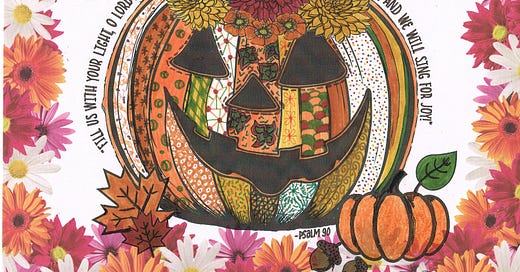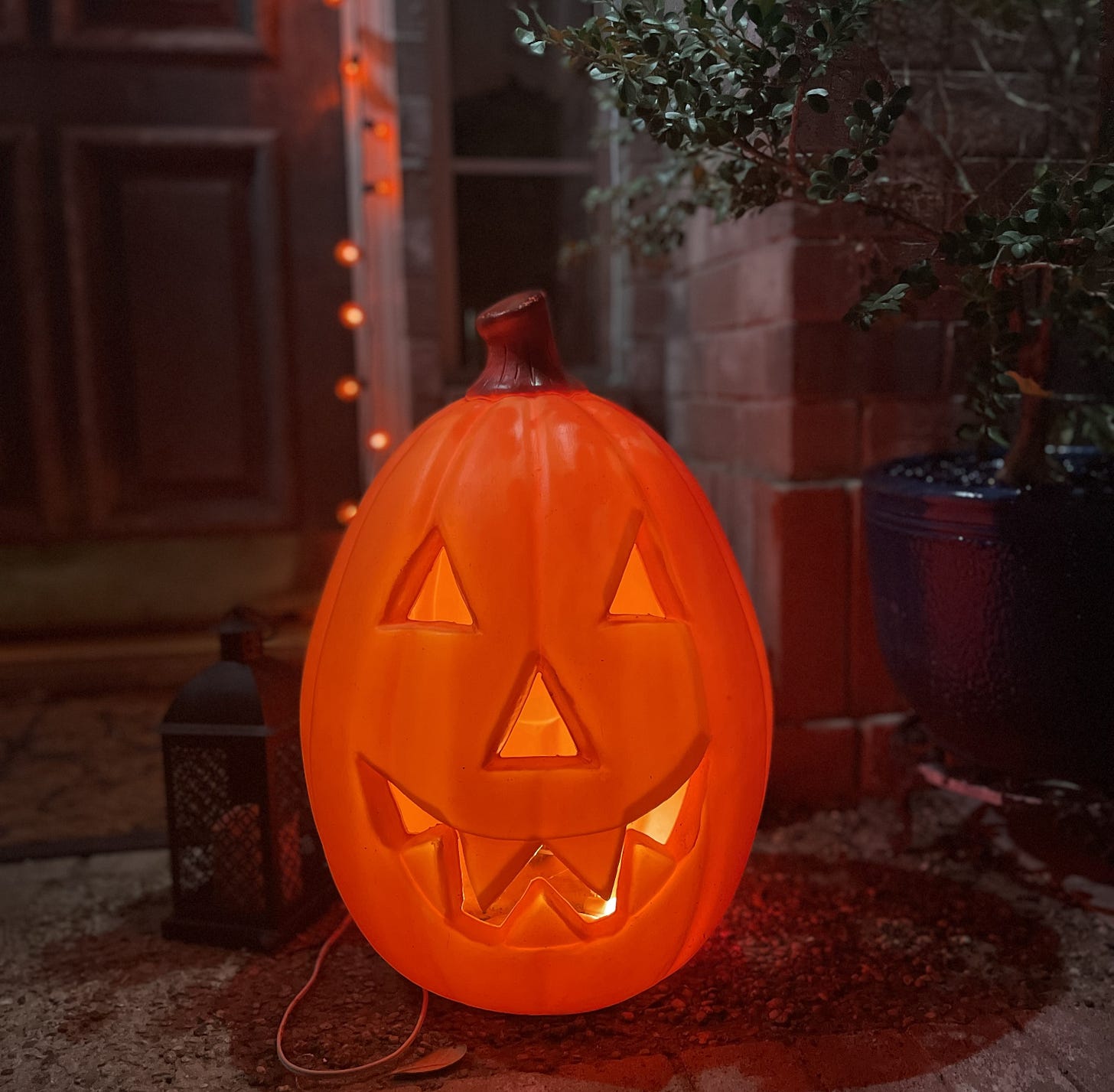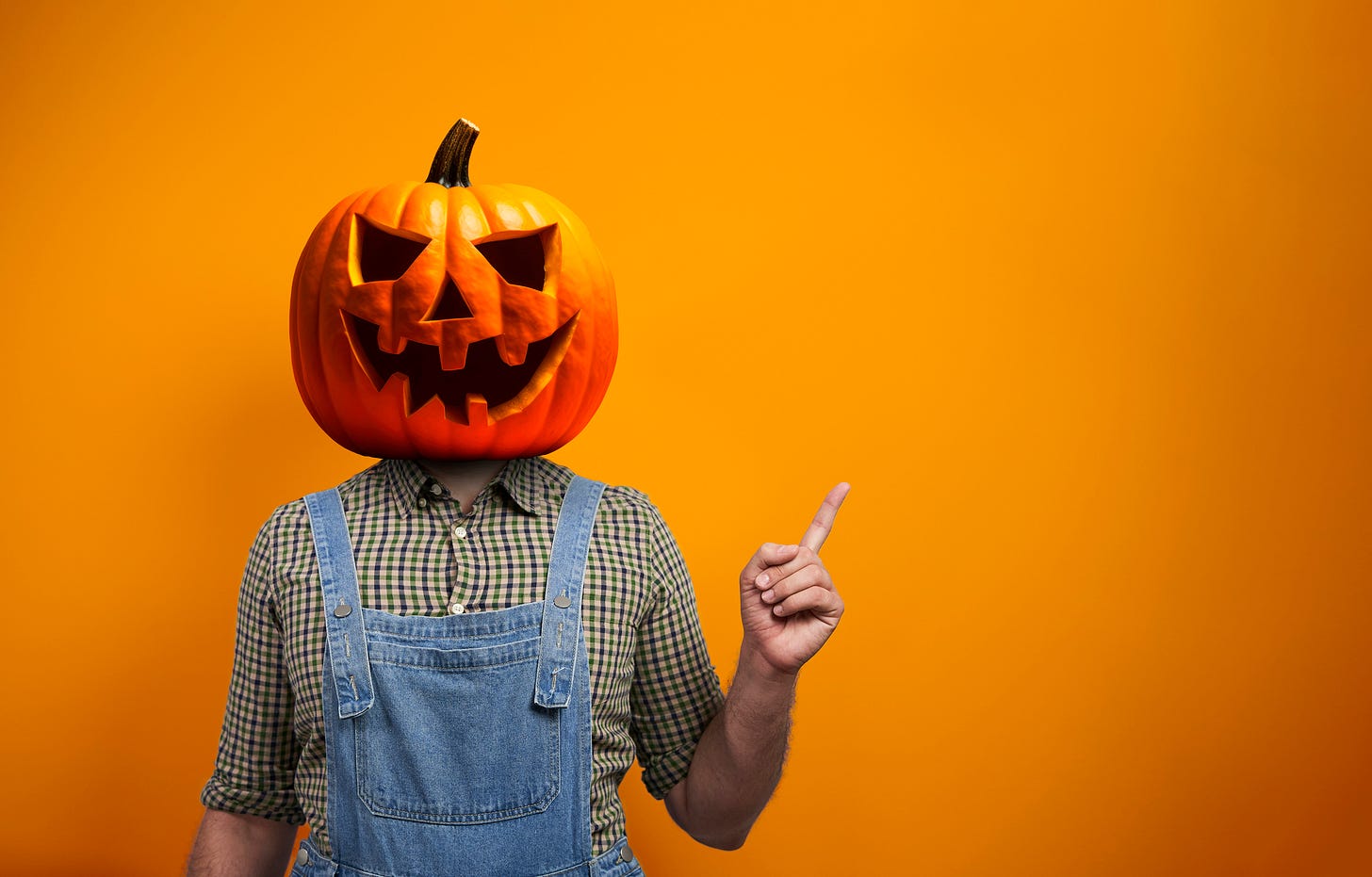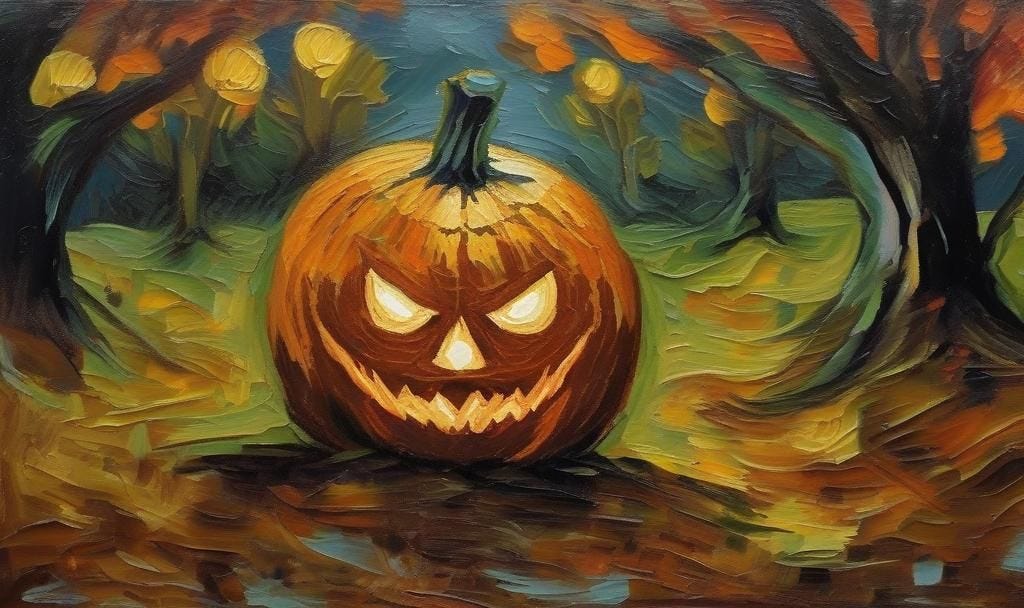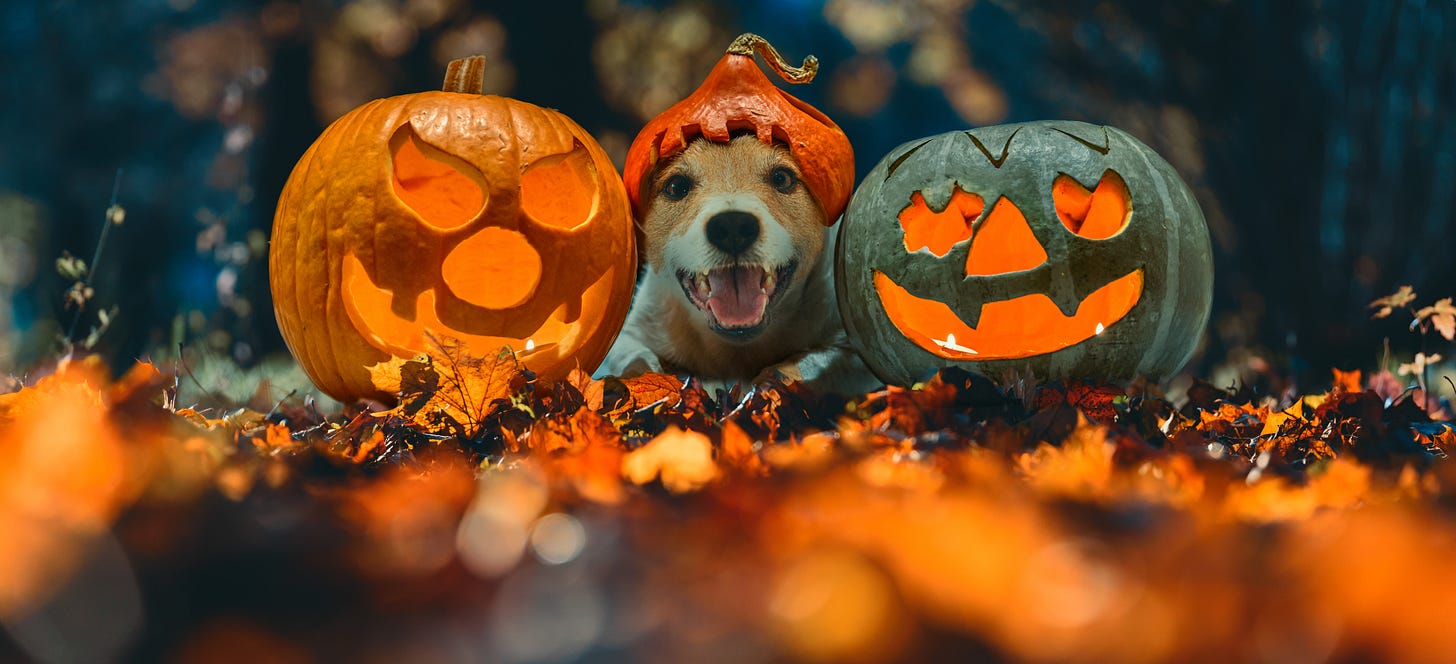Symbols of the Season: The Jack o' Lantern
Hospitality, Mockery and Purifying Light
Fill us with your light, O Lord, and we will sing for joy!” - Psalm 90
I emigrated to the US with my family when I was a child. The country we came from did not celebrate Halloween. It wasn’t that Halloween was ignored or rejected; it just wasn’t even a thing to consider in the first place.1
Because the costumes, candy and parties were so foreign to us, my parents had a strict anti-Halloween policy. While my friends at school were getting their costumes together and talking about the best neighborhood candy route, I knew I would be staying home, with the front porch light out and the curtains drawn. I wasn’t particularly angry or upset about it. That’s just how it was. But regardless, this strange holiday popped into my mind with a big question mark every October, forcing me to think about it, to consider it as an outsider looking in.
A couple of decades later, our first child came into the world on Halloween. Once again, year after year, Halloween featured loud and large every October. For the first few years of my daughter’s life, we pretty much ignored it and focused only on her birthday. But as she grew older, this was no longer possible. She wanted her friends to come for her birthday; they wanted to go trick or treating. She also wanted to be part of the fun and festivity happening on “her day.” So eventually, we jumped on the bandwagon. We put up Halloween decorations, hosted parties and started handing out candy. We joined in the hayrides, bobbed for apples and trailed around the neighborhood with other parents, collecting candy.
And somewhere during these slow walks in all these repeating October months, my perspective on Halloween began to change. I started to see it differently.
I spend a lot of time teaching about signs, symbols, sacramentals and Sacraments. The Catechism reminds us that “as a being at once body and spirit, man expresses and perceives spiritual realities through physical signs and symbols.” (CCC 1146) The Catholic understanding that just about everything means something and is part of an overall system of communication and purification is pervasive, taking everything in and leaving practically nothing out.
If doves can represent a bird, but also peace, as well as Baptism and the Holy Spirit, then could it also be true that the signs and symbols we associate with Halloween are part of the same system of communication? I mean specifically, in that each of the signs and symbols we associate with Halloween have a certain meaning.
Let’s take the Jack o’ Lantern, for example. When we decided to put up some Halloween things, the 2 foot, plastic, light up Jack o’ Lantern above was the first thing I bought. Even now, when I pull up to the house at night and see it sitting outside the front door, smiling and softly glowing in the dark, I feel happy. For some reason, this silly pumpkin makes me feel safe, as though there is friendship and hospitality to be found in this home. It’s warm and welcoming, and I miss its glow when we put it away. I love its orange color, so rich and homey. It makes me think there’s a fire and a bowl of hot soup waiting inside. But I especially like the gentle glow emanating from within. It’s the light within that makes the Jack o’ Lantern a Jack o’ Lantern.
In fact, that’s the origin of the phrase ‘Jack o’ Lantern.’ The Oxford English Dictionary records the use of the term in Britain “from 1663 to 1704, in reference to a man with a lantern or to a night watchman.”2 The night watchman was Jack (of the) lantern, shortened to Jack o’ Lantern. The sight of a nightwatchman would indeed have been very comforting, I imagine, during those long, cold, dark nights in Britain when people longed for and looked for the light of the dawn. Seeing a light in the dark is still comforting now, even with electricity.
The meaning of the Jack o’ Lantern eventually changed to refer to a lantern carved from a turnip or pumpkin, and the OED gives 1837 as the earliest date for when the term was used with this meaning.3 Setting a candle in a gourd makes a lot of sense. Gourds were handy and could be carved to hold something within or placed on a shelf out of reach of children. It reminds me of the Celtic custom of putting candles in the window, to guide people in need of shelter.
So, Jack o’ Lanterns are known for their ability to give off light, to shine in the dark and to offer safety and security to those nearby. As a symbol, it’s probable that they have a connection to illuminating the intellect as well, since they almost always represent a giant head.
But we also have to recognize that there’s another side to this carved up pumpkin, the shadow side of the symbol. Some pumpkins are warm and welcoming, like the one above. But others carry a warning. A Jack o’ Lantern can certainly represent hospitality and friendship, but it can also signify mockery and misunderstanding. A smile can be sincere or malicious. Inviting a stranger in who is pretending to be a friend, but who really comes in to steal, can be very dangerous. We can’t just be naive, either.
In fact, although Jack o’ Lanterns began as just that, lanterns, their use has changed over the years. There are poems and records detailing the way scary images were carved into pumpkins, springing from a belief that this would somehow ward off evil spirits believed to be around, especially on October 31st. The history of the Jack o’ Lantern is interesting and is seen in various versions in many cultures in different parts of the world.4
The Liturgical Calendar is also helpful in giving us the right perspective. Emphasizing the eve of the feast day of All Saints Day is in keeping with our emphasis on both Christmas eve and the eve of Easter Sunday, when the magnificent Easter Vigil Mass takes place. At both the Christmas Eve Mass and especially at the Easter Vigil Mass, something crucial takes place.5 The Light of Lights comes into the world. Jesus has already been born at Christmas Day Mass. His resurrection has already taken place on Easter morning. But the saving action of God takes place in the dark before the dawn, because Jesus said, "I have come into the world as a light, so that no one who believes in me should stay in darkness."(John 12:46) The Light of God breaks into the world of darkness and sin, unseen, in the dark.
The Major Triduum of Holy Thursday to Easter Sunday are all about the glory of God. But the Minor Triduum of Hallowtide - Halloween, All Saint’s Day and All Soul’s Day, is about allowing the purifying light of God to soak into us, down deep into our souls and into our bones, so that we can join the cloud of witnesses, so that we can move from the darkness of the night into the dawn of the light. As Scripture says, “The light shines in the darkness, and the darkness has not overcome it.” (John 1:5) Both Christmas Eve and the Easter Vigil focus on the life and saving actions of Jesus. But Hallowtide focuses on the light of Jesus in us, and especially how that purifying light shone forth in the lives of the saints we honor and remember on November 1st.
So then, on Halloween, are we in fact, albeit unknowingly, naming the impurities that are keeping us from God by putting out scary objects just like our ancestors did, to scare away the things that go bump in the night? Do we gravitate towards one symbol over another, spiders over witches, for example, or skeletons instead of Dracula, because we are unconsciously recognizing and pointing to something unseen within? Specific tendencies that live in ourselves and our homes? I wonder if this is, after all, a Rumpelstiltskin moment, when we have the chance to name the evil spirit dancing in the dark and, once having named it, we can actively begin to remove it from ourselves and our homes by joining in the chorus of saints and angels on November 1st and praying for those still on the way on November 2nd.
These are the random thoughts I think about on an October evening. As I walk the dogs around the neighborhood at night, I look at the various Halloween decorations sitting on the lawn outside people’s homes. Halloween, with all its symbols, reminds us that we aren’t there yet. We are still waiting and watching in the dark, looking for the light of the dawn, and the Jack o’ Lantern can remind us to “be transformed by the renewal of your mind,” that we may discern what is the will of God (Romans 12:2). We can see and name all those impurities that are keeping us in the dark, and pray with the psalmist, “Fill us with your light, O Lord, and we will sing for joy!” (Psalm 90)
My cousins often comment on the pervasiveness of American culture. In fact, when they come to visit, they want to visit Whataburger, Target and Taco Bell.
Jack-o'-lantern - Wikipedia
Ibid.
Other writers have already done a great job of explaining how we got to the current understanding of Halloween and the use of Jack o’ Lanterns, so I’m not going to spend too much time on that, interesting as it may be.
Every Sunday Mass commemorates the resurrection of Jesus and makes present the self-offering of Christ back to the Father through the Holy Spirit, but the Solemnities of Christmas Eve Mass and especially the Easter Vigil Mass take primacy of place in the liturgical year. Without the Major Triduum, there would be no Minor Triduum.


